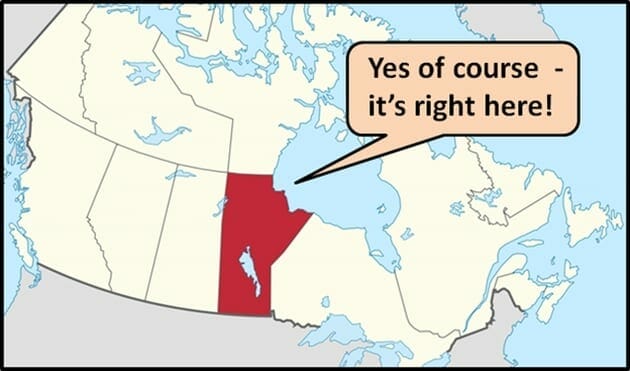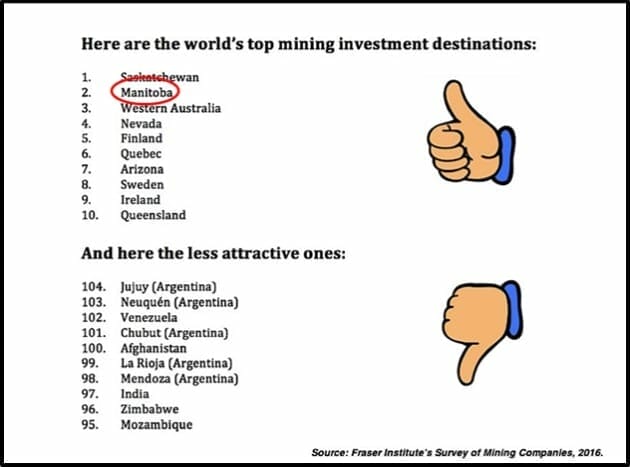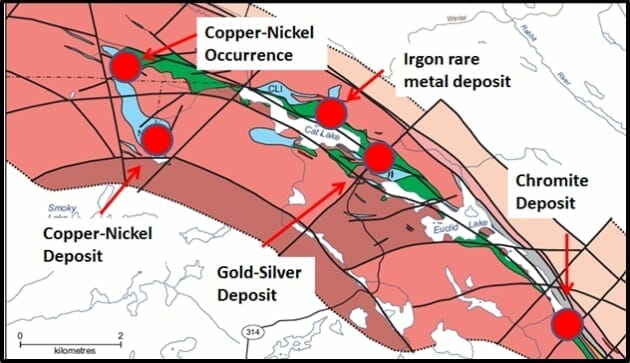On September 19, 2017, QMC Quantum Minerals (QMC.V) got a work permit from the Government of Manitoba for the Irgon Lithium Mine property. QMC has now mobilized a work crew and equipment to the site.
QMC has a simple mandate.
“To locate and develop economic precious, base, rare metal and resource properties of merit. The Company’s properties include the Irgon Lithium Mine project two VMS properties, the Rocky Lake and Rocky-Namew known collectively as the Namew Lake District Project, and the Carrot River Gold Property. Currently, all of the company’s properties are located in Manitoba”.
Some out-of-country Equity Guru readers may not be familiar with the Canadian province of Manitoba.
Basically, if Canada was a BLT sandwich, Manitoba would slide in between the mayonnaise and the bacon.
A February, 2017 Mining.com report stated:
“Two Canadian provinces — Saskatchewan and Manitoba — are the world’s top two most attractive mining investment destinations, displacing Western Australia from the first to the third place, the latest annual global survey of mining executives released Tuesday by the Fraser Institute shows.”
QMC investors have reason to be optimistic about the spodumene-bearing Irgon Dike.
A dike is a sheet of rock that forms when magma intrudes into a crack then crystallizes.
Spodumene is a major source of lithium, which can be extracted easily from spodumene by acid fusion. Global production of lithium via spodumene is about 80,000 metric tonnes a year.
The initial work program at the Irgon Lithium Mine property will strip the overburden off the dike, exposing it along strike. QMC will then begin channel sampling to extend the known mineralized zone and confirm previous grab sampling, trenching and drilling results.
Officially, QMC is a grassroots project. Unofficially, it’s sitting on a mountain of historical data that, at the very least, offers a guide for modern day explorers.
Between 1953-1954, the Lithium Corporation of Canada Limited drilled 25 holes into the Irgon Dike and reported a historical resource estimate (which is not NI 43-101 compliant and thus cannot be relied upon) of 1.2 million tons grading 1.51% Li2O over a strike length of 365 meters and to a depth of 213 meters.
Because the data is “historical”, QMC is required to use cautionary language, and readers are asked to not place too much reliance on the old stats because they were gathered under different rules and time often changes things on the ground:
“This historical resource is documented in a 1956 Assessment Report by Bruce Ballantyne
for the Lithium Corporation of Canada Ltd. (Manitoba Assessment Report No. 94932).
This historical estimate is believed to be based on reasonable assumptions and the
company/QP has no reason to contest the document's relevance and reliability. A detailed drill program will be required to update this historical resource to current NI 43-101
standards.” […] Historic metallurgical tests reported an 87% recovery from which a concentrate averaging 5.9% Li2O was obtained”
Eventually, QMC will need to run a full-blown drill program, to bring this historical resource to NI 43-101 standards, so we really know what’s in there. Given that the asset is in Manitoba, the drill program shouldn’t be difficult to finance.
“During this historical 1950 era work program, a complete mining plant was installed on site designed to process 500 tons of ore per day and in addition, a three-compartment shaft was sunk to a depth of 74 meters. The work was suspended in 1957, awaiting a more favourable market for lithium oxides.”
That favourable market has arrived.
Lithium demand is currently about 33,000 tonnes per year, 30% for lithium-ion batteries, 25% for glass manufacture, multiple minor applications, including nuclear power.
In 2016, lithium-ion battery revenues were $3 billion. By 2040 the market should be worth a lot more.
QMC has other valuable properties in Manitoba, including the 55,352 hectare Rocky Lake VMS Project.
The total area of Manitoba is 647,797 km². That’s the same size as the U.K, Austria, Czech Republic, Croatia and Denmark put together. But Manitoba only has 1.3 million people.
In an environment where anti-mining protests are becoming the norm, it’s advantageous for a junior explorer to be operating in a sparsely populated mining-friendly jurisdiction. That’s an attractive profile for a junior explorer: Big area, small population, good mining jurisdiction, past producing mine.
Let’s keep an eye on the channel sampling program.
QMC is trading at .16 with a market cap of $6.6 million.
Full Disclosure: Quantum Minerals is an Equity Guru marketing client, and we participated in a recent financing.




